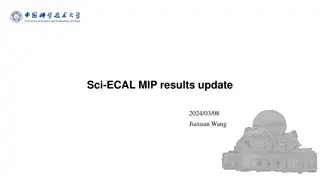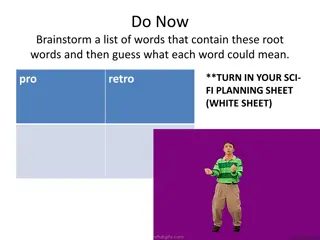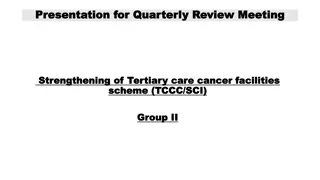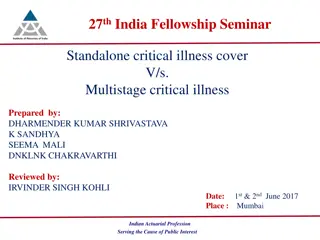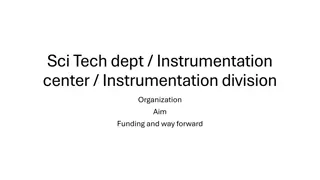
Understanding the Impact of Montessori Education on Cognitive Development and Creative Thinking
Explore the significance of early educational experiences, specifically in Montessori classrooms, on concept learning, cognitive processes, and creative thinking. Investigate the effects of semantic representation on cognitive abilities and the potential benefits of a network-based approach to studying cognitive flexibility.
Download Presentation

Please find below an Image/Link to download the presentation.
The content on the website is provided AS IS for your information and personal use only. It may not be sold, licensed, or shared on other websites without obtaining consent from the author. If you encounter any issues during the download, it is possible that the publisher has removed the file from their server.
You are allowed to download the files provided on this website for personal or commercial use, subject to the condition that they are used lawfully. All files are the property of their respective owners.
The content on the website is provided AS IS for your information and personal use only. It may not be sold, licensed, or shared on other websites without obtaining consent from the author.
E N D
Presentation Transcript
2021 IF = 4.350 SSCI, SCIE JCR Q1 2022 3 28
Main Authors Solange Denervaud PhD/Post-doc University of Lausanne Roger E. Beaty Asst. Prof. Pennsylvania State University Cognitive flexibility and creativity development behavior, fNIRS, MRI, and modelization. Creative thinking Network analysis, fMRI, tES-fNIRS 2
Introduction Early experience is importance for Early experience is importance for concept especially especially school school education education Montessori Multi-age classes Interdisciplinary, discovery-based work Traditionally Successively different topics Learn & memorize concepts Montessori Montessori vs. vs. Tranditional Tranditional classes functions functions (e.g., Besan on et al., 2008; Denervaud et al., 2019) better academic outcomes socio-emotional learning divergent and/or convergent creativity concept learning, learning, classes in in higher cognitive higher cognitive 3
Introduction Such effects raise questions about fundamental Such effects raise questions about fundamental cognitive cognitive processes processes such as concept learning. Semantic representation impacts many Semantic representation impacts many important cognitive abilities cognitive abilities ( (Gobbo Gobbo & & Chi, e.g., creative thinking important Chi, 1986) 1986) by influencing how knowledge is retrieved from memory 4
Introduction Paradigm shift in the study of Semantic Paradigm shift in the study of Semantic representation representation (e.g., Drieger, 2013; Christensen et al., 2018) A simple verbal fluency task Cognitive network methods Network science measures Network science measures Higher creative individuals show more efficient and flexible network structure (Kenett & Faust, 2019) Average shortest path length (ASPL) Global Global efficiency efficiency Clustering coefficient (CC) Local Local efficiency efficiency Modularity (Q) F Flexibility lexibility 5
Research gap Summary Summary Montessori classes show advantage Property of semantic network impact higher cognitive functions. H However, owever, i it is unknown t is unknown whether differences differences: : whether educational educational impact what concepts we learn & how concepts represented in semantic memory and further impact creative thinking 6
Methods Participants Participants 7
Methods Tasks Tasks Verbal fluency Construct Construct Network Network To name as many animals as he/she could in 60 s Creativity assessment Divergent thinking To draw as many different drawings as possible from one imposed abstract form (i.e., incomplete shape) in 10 min Convergent thinking To select 3 different abstract forms out of 8 to create an original drawing that combined them in 15 min 8
Results More More creative creative response Children Children response for for Montessori Montessori than than Traditional Traditional 9
Results More More efficient efficient and and flexible semantic network structure flexible semantic network structure Clustering coefficient ( ) Average shortest path length Modularity 10
Discussion Specific teaching practices found in Montessori Specific teaching practices found in Montessori classes may foster higher creativity skills foster higher creativity skills classes may such as the error-and trial approach (children need to solve problems by and for themselves) the peer-peer tutoring in multi-age classes (higher social diversity, different points of view) The semantic network and creativity results are The semantic network and creativity results are consistent with studies in adults with studies in adults (Kenett, 2019; Kenett et al., 2018) consistent Efficiency Efficiency and and flexibility flexibility of of Semantic Semantic network network - -> > creativity creativity Limitations Limitations It is a cross-sectional study It is unknow that which feature(s) from the Montessori education help(s) 11
Conclusion Education impacts how children represent concepts in semantic memory. Different educational experiences can affect higher cognitive functions, including creative thinking. 12
Further reading 1. Li, Y., Kenett, Y. N., Hu, W., & Beaty, R. E. (2021). Flexible semantic network structure supports the production of creative metaphor. Creativity Research Journal, 33(3), 209-223. Kenett, Y. N., Levy, O., Kenett, D. Y., Stanley, H. E., Faust, M., & Havlin, S. (2018). Flexibility of thought in high creative individuals represented by percolation analysis. Proceedings of the National Academy of Sciences, 115(5), 867-872. Kenett, Y. N., Betzel, R. F., & Beaty, R. E. (2020). Community structure of the creative brain at rest. Neuroimage, 210, 116578. Kenett, Y. N., & Faust, M. (2019). A semantic network cartography of the creative mind. Trends in cognitive sciences, 23(4), 271-274. Beaty, R. E., Chen, Q., Christensen, A. P., Kenett, Y. N., Silvia, P. J., Benedek, M., & Schacter, D. L. (2020). Default network contributions to episodic and semantic processing during divergent creative thinking: A representational similarity analysis. NeuroImage, 209, 116499. 2. 3. 4. 5. 13
Reflection 14










